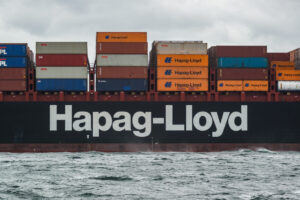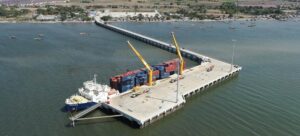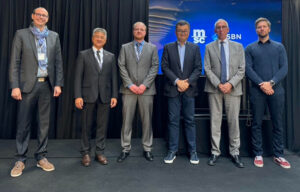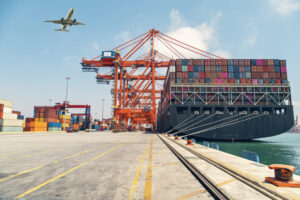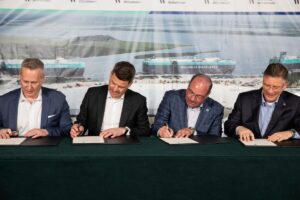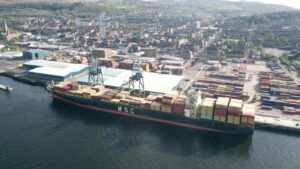Danish naval architect company KNUD E. HANSEN has recently been developing a number of pioneering container feeder vessel designs.
The first in the series of three designs relates to a 2000 TEU vessel that was conceived to specialise in calling at small, narrow, up-river ports, for example the Port of Bangkok, Thailand.
Navigating such harbours requires a vessel to have a shallow draught – in the case of Bangkok, not more than 8.2 metres.
Jesper Kanstrup, Senior Naval Architect at Knud E. Hansen, said: “The dual arrangement makes up for the relative small diameter of the propellers. The total propeller disk area of the two propellers corresponds to the area of a single propeller with a diameter of approximately 7.4 metres and further, the counter-rotating propeller will recover some of the swirl energy produced by the main propeller, which increases the overall efficiency.”
A second design includes a vessel which does not require such a shallow draught and which will have a 3,800 TEU capacity.
With draught not being a primary consideration, this design sees the feeder vessel fitted out with a larger diameter, slower-turning propeller.
(Source: KNUD E. HANSEN)
Unlike most feeder vessels, the deckhouse of this vessel is positioned slightly forward of amidships to maximise the number of container slots on deck considering the IMO requirements to the line of vision from the bridge.
The added number of slots can be utilised in real-life loading conditions because the vessel is wider and has a higher stability than most feeder vessels of this size.
Kanstrup continues: “This prepares the vessel for LNG and dual-fuel propulsion – attributes that are becoming increasingly sought after. Here, we have a square block below the deckhouse, in which we can either have HFO tanks or LNG tanks.
“What’s more, the vessel can be built with HFO tanks and easily retrofitted for LNG the day the infrastructure for LNG is sufficiently developed if a dual-fuel engine is installed in the first place.”
The design is being developed in consultation with DNVGL with the aim to achieve an Approval in Principle, which Mr Kanstrup says will help make the design easier to market.
The third arrangement sees the application of a hull shape suited for carriage of both partial and full container loads.
The problem arises due to the differing ways in which a vessel behaves based upon its load.
A large container vessel, when carrying few containers, offers shallow draught, but has so much stability that accelerations are too high, causing problems for the lashing gear and the crew.
Mr Kanstrup said: “In this situation, you don’t want anything more than sufficient stability and so a narrow hull is preferable.
“The problem being that, when you come to carrying a full load you require a wider water line for additional stability.
“So the ideal hull would have inclined hull sides with narrow water lines at shallow draught and wider water lines at deeper draughts, which, however, is not the most practical design considering the vertical quays in ports.”
The solution proposed by Knud E. Hansen is that instead of a conventional hull you take a hull with inclined sides, but mirror the triangular sections in each side to create a trimaran or in better words a “stabilised mono-hull” with a narrow main hull with vertical sides and outrigger hulls with a triangular cross section, but vertical sides towards the quay.
“We were looking for something that answers the slow steaming problem. With the advent of slow steaming, for certain goods, air freight has become a more popular choice as the cargo arrives faster.
Kanstrup concluded: “And moving goods from sea transport to air freight does not have a positive effect on the CO2 emission. With a design such as this we have a vessel that could bridge the gap between slow steaming container ships and air freight.”
(Source: KNUD E. HANSEN AS / YouTube)



